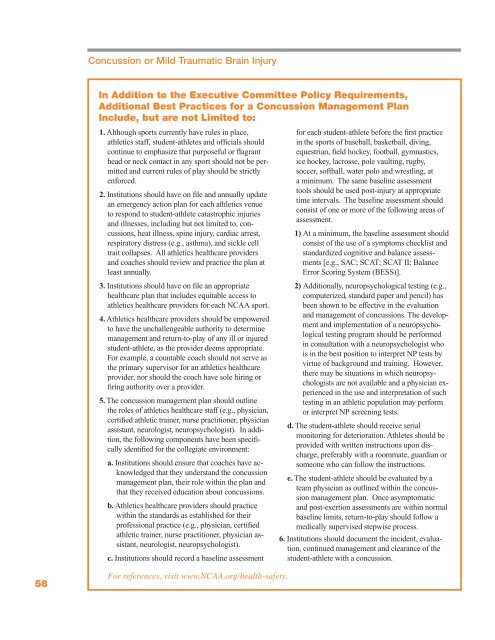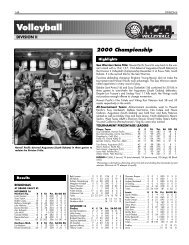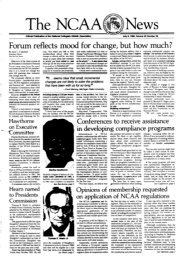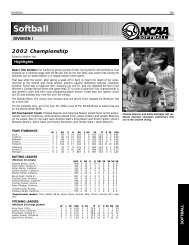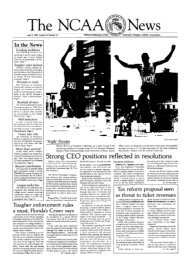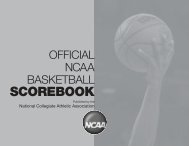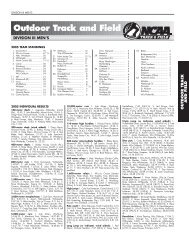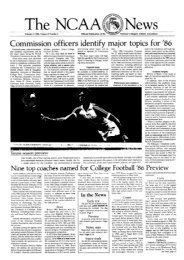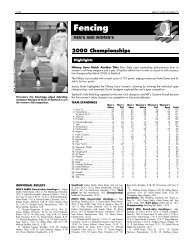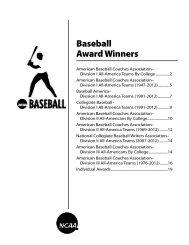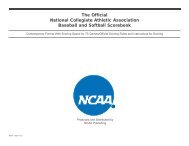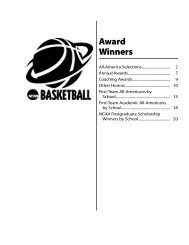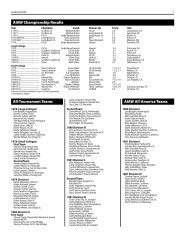Sports Medicine Handbook - NCAA
Sports Medicine Handbook - NCAA
Sports Medicine Handbook - NCAA
Create successful ePaper yourself
Turn your PDF publications into a flip-book with our unique Google optimized e-Paper software.
58<br />
Concussion or Mild Traumatic Brain Injury<br />
In Addition to the Executive Committee Policy Requirements,<br />
Additional Best Practices for a Concussion Management Plan<br />
Include, but are not Limited to:<br />
1. Although sports currently have rules in place,<br />
athletics staff, student-athletes and officials should<br />
continue to emphasize that purposeful or flagrant<br />
head or neck contact in any sport should not be permitted<br />
and current rules of play should be strictly<br />
enforced.<br />
2. Institutions should have on file and annually update<br />
an emergency action plan for each athletics venue<br />
to respond to student-athlete catastrophic injuries<br />
and illnesses, including but not limited to, concussions,<br />
heat illness, spine injury, cardiac arrest,<br />
respiratory distress (e.g., asthma), and sickle cell<br />
trait collapses. All athletics healthcare providers<br />
and coaches should review and practice the plan at<br />
least annually.<br />
3. Institutions should have on file an appropriate<br />
healthcare plan that includes equitable access to<br />
athletics healthcare providers for each <strong>NCAA</strong> sport.<br />
4. Athletics healthcare providers should be empowered<br />
to have the unchallengeable authority to determine<br />
management and return-to-play of any ill or injured<br />
student-athlete, as the provider deems appropriate.<br />
For example, a countable coach should not serve as<br />
the primary supervisor for an athletics healthcare<br />
provider, nor should the coach have sole hiring or<br />
firing authority over a provider.<br />
5. The concussion management plan should outline<br />
the roles of athletics healthcare staff (e.g., physician,<br />
certified athletic trainer, nurse practitioner, physician<br />
assistant, neurologist, neuropsychologist). In addition,<br />
the following components have been specifically<br />
identified for the collegiate environment:<br />
a. Institutions should ensure that coaches have acknowledged<br />
that they understand the concussion<br />
management plan, their role within the plan and<br />
that they received education about concussions.<br />
b. Athletics healthcare providers should practice<br />
within the standards as established for their<br />
professional practice (e.g., physician, certified<br />
athletic trainer, nurse practitioner, physician assistant,<br />
neurologist, neuropsychologist).<br />
c. Institutions should record a baseline assessment<br />
For references, visit www.<strong>NCAA</strong>.org/health-safety.<br />
for each student-athlete before the first practice<br />
in the sports of baseball, basketball, diving,<br />
equestrian, field hockey, football, gymnastics,<br />
ice hockey, lacrosse, pole vaulting, rugby,<br />
soccer, softball, water polo and wrestling, at<br />
a minimum. The same baseline assessment<br />
tools should be used post-injury at appropriate<br />
time intervals. The baseline assessment should<br />
consist of one or more of the following areas of<br />
assessment.<br />
1) At a minimum, the baseline assessment should<br />
consist of the use of a symptoms checklist and<br />
standardized cognitive and balance assessments<br />
[e.g., SAC; SCAT; SCAT II; Balance<br />
Error Scoring System (BESS)].<br />
2) Additionally, neuropsychological testing (e.g.,<br />
computerized, standard paper and pencil) has<br />
been shown to be effective in the evaluation<br />
and management of concussions. The development<br />
and implementation of a neuropsychological<br />
testing program should be performed<br />
in consultation with a neuropsychologist who<br />
is in the best position to interpret NP tests by<br />
virtue of background and training. However,<br />
there may be situations in which neuropsychologists<br />
are not available and a physician experienced<br />
in the use and interpretation of such<br />
testing in an athletic population may perform<br />
or interpret NP screening tests.<br />
d. The student-athlete should receive serial<br />
monitoring for deterioration. Athletes should be<br />
provided with written instructions upon discharge,<br />
preferably with a roommate, guardian or<br />
someone who can follow the instructions.<br />
e. The student-athlete should be evaluated by a<br />
team physician as outlined within the concussion<br />
management plan. Once asymptomatic<br />
and post-exertion assessments are within normal<br />
baseline limits, return-to-play should follow a<br />
medically supervised stepwise process.<br />
6. Institutions should document the incident, evaluation,<br />
continued management and clearance of the<br />
student-athlete with a concussion.


